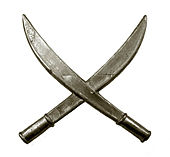91st Punjabis (Light Infantry)
| 91st Punjabis (Light Infantry) | |
|---|---|
 |
|
| Active | 1903 - 1922 |
| Country |
|
| Branch |
|
| Type | Infantry |
| Size | 2 Battalions |
| Uniform | Red; faced dark green; green in 1882 Drab; faced cherry in 1894 |
| Engagements |
Third Anglo-Maratha War 1817-19 Coorg War 1834 Indian Rebellion of 1857 Pacification of Upper Burma 1890-96 Boxer Rebellion 1900 First World War 1914-18 (Mesopotamia, Palestine) |
| Commanders | |
| Colonel of the Regiment |
Lt Gen Henry D'Urban Keary, KCB, KCIE, DSO |
The 91st Punjabis (Light Infantry) was an infantry regiment of the British Indian Army. The regiment was raised in 1800 as a battalion of Madras Native Infantry. It was designated as the 91st Punjabis in 1903 and became 3rd Battalion 8th Punjab Regiment in 1922. In 1947, it was allocated to Pakistan Army, where it continues to exist as 3rd Battalion of The Baloch Regiment.
The origin of regiment can be traced back to 1759 when it was first raised as Irregular Troops of East India Company and was formed into a Battalion of "Coast Sepoys". It was converted into regulars on 1 January 1800 at Trichonopoly as the 1st Battalion 16th Regiment of Trichnopoly Native Infantry by Lieutenant Colonel S Jennerett and was known as Jennerett ki Paltan (Jennerett's Battalion). It was composed mostly of Muslims, Tamils and Telugus of South India. In 1811, it was styled as Trichonopoly Light Infantry as reward for a 25-mile forced march in support of a retreating force; when it arrived just in time to turn the tables in a minor engagement near Mysore. In 1817-19, the regiment took part in Third Anglo-Maratha War, where it greatly distinguished itself in the Battle of Mahidpur. In 1824, it was redesignated as the 31st Regiment of Madras Native Infantry.
In 1887, the battalion was formed into SHWEBO BATTALION of UPPER BURMA POLICE and between 1887-1890 remained engaged in eliminating the rebels of SHWEBO area in Central Burma where it captured the WUNTHO SWABWA's DAH and SHEATH which latter became part of its cap badge. On 1 February 1892 the battalion was designated as 31st Madras Light Infantry( 6th Burma Battalion)with Capt HDU Keary as the Commanding Officer who went to command it for 23 years at stretch till 1909.From 1900to1912 battalion operated in China as a part of Expeditionary Force in Boxer Rebellion. On 3 October 1903 the battalion was renamed as 91st PUNJABIS. On 6 February 1906 the Unit was presented Regimental and Royal Colors at Bhamo, Burma. After 31 years of service in Burma. the Unit proceeded overseas in 1916 for World War 1 where it saw actions at Mesopotamia and Palestine.
...
Wikipedia
